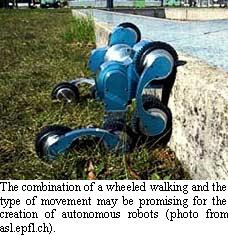 Establishment of mobile robots able to operate on rough terrain, not an easy task. The main problem - recognition of obstacles. The drive is the same (wheels, tracks, hands and feet) - a question secondary. One way of orientation, move to the touch, is still undervalued.
Establishment of mobile robots able to operate on rough terrain, not an easy task. The main problem - recognition of obstacles. The drive is the same (wheels, tracks, hands and feet) - a question secondary. One way of orientation, move to the touch, is still undervalued.Over the decades, that people build such devices, which just does not come. Mainly designers use cameras, infrared and ultrasonic sensors.
Meanwhile, to perform a specific range of tasks the machine is not necessarily directly copy human functions.
A couple of years ago, Swiss Federal Institute of Technology in Lausanne (EPFL) has created a very original robot Octopus ("Octopus").
However, the robot logically be called "Osmikolesom" as to recognize the obstacles he uses sensitive wheel, of which the robot exactly eight pieces.
Inside each wheel are hidden 16 infrared sensors, which measure the deformation of the tire caused by contact with soil, stones and other objects.
In fact, this system acts as a tactile sensor.
The oddest thing - sensors are installed so that they remain motionless until the tire rotates around them.
The tire rests its edges into two separate rings, rotating on bearings with seal. Sensors is actually installed on the hub.
Wheels attached to the system of levers, also fitted with engines. They allow the machine to not only roll, but to walk.
This involves the ability of the device during lifting of the obstacles.
Although the machine apparently did not look like an octopus, whose name it is called, its way of movement resembles the action of this marine animal.
First, the octopus feels stones, just as it does a robot. Secondly, wanting to get taller, throws the octopus tentacles on the front obstacle, and then tightens the body, then picks up the rear "feet".
Similarly, Octopus, when the front wheel feels a wall, picks it up, while shifting forward until the second wheel touches the step.
Then, the robot continues to rise, acting engine "hands" and "forearm" so that the front wheel followed the profile of the landscape and would reach the horizontal section.
Then the machine starts to catch up. Weight at this point the robot is distributed only between the outer wheels.
Interestingly, the program that controls the robot, allows it to assess the seriousness of the obstacles and select the "storm" or search crawl.
Moreover, as emphasized by the Swiss, the only equation that must be met to achieve balance machine - the equation of torque in relation to its various axes.
This relatively simple mathematical problem allows you to "sew up" management program in a relatively simple chip that can cope with the problem in real time.
We are far from that in developing this machine on, EPFL has made a revolution in building robots for rough terrain.
However, in a variety of variations of the idea of autonomous mechanisms of tactile wheels, in our opinion, deserves mention not only as a curiosity, but also a revival in some other designs.
Maybe it is that technology as a complement to other sensors, not enough participants DARPA Grand Challenge, to safely finish the race over rough terrain?
But, somehow, on tactile sensors for robots, is now spoken by only applying to "iron" the hands or feet of humanoid machines.